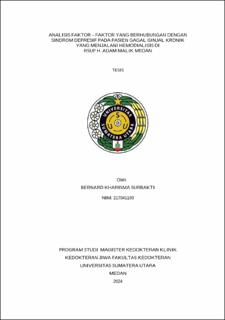Analisis Faktor – Faktor yang Berhubungan dengan Sindrom Depresif pada Pasien Gagal Ginjal Kronik yang Menjalani Hemodialisis di RSUP H Adam Malik Medan
Analysis of Factors Associated with Depressive Syndrome in Chronic Renal Failure Patients Undergoing Hemodialysis at RSUP H Adam Malik Medan

Date
2024Author
Surbakti, Bernard Kharisma
Advisor(s)
Effendy, Elmeida
Husada, M Surya
Metadata
Show full item recordAbstract
Background: Chronic Kidney Disease is a disorder of the kidneys characterized by abnormalities in kidney structure or function that last more than 3 months. According to data from the Indonesian Nephrology Association in 2012, the prevalence of CRF in Indonesia was 12.5% based on gender, the highest prevalence of men (0.3%) while in women (0.2%), hemodialysis was the most widely used method, compared to other types of dialysis (16%). Hemodialysis can replace kidney function to regulate body fluids, electrolytes and metabolism. This study wanted to analyze the factors associated with depressive syndrome in chronic renal failure undergoing hemodialysis.
Method: This study is a multivariate analytical study with a cross-sectional study approach. Sampling using non-probability sampling type consecutive sampling technique. Samples were obtained from 97 patients with chronic renal failure who underwent hemodialysis at the hospital. H. Adam Malik Medan.
Method: This research is a multivariate analytical study with a cross-sectional study approach. Sampling using non-probability sampling type consecutive sampling technique. Samples were obtained from 97 patients with chronic renal failure who underwent hemodialysis at the hospital. H. Adam Malik Medan.
Results: Data from 97 patients with chronic renal failure who underwent hemodialysis who participated showed that the age variable of CRF patients undergoing hemodialysis had a positive correlation coefficient with r = 0.204 on depression, which means that the higher the age of CRF patients undergoing hemodialysis, the higher the BDI II score, meaning the higher the depression in CRF patients undergoing hemodialysis. The sex variable of CRF patients undergoing hemodialysis has a positive correlation coefficient with r = 2.696, which means that in CRF patients undergoing male hemodialysis, the higher the BDI-II score, meaning the higher the depression in male patients undergoing hemodialysis. The old variable of CRF patients undergoing hemodialysis has a negative correlation coefficient of depression with r = - 4.015 which means that the longer CRF patients undergo hemodialysis, the lower the BDI-II score, meaning the lower the depression in CRF patients undergoing hemodialysis. The comorbid disease variable of CRF patients undergoing hemodialysis has a positive correlation coefficient with r = 3.270, which means that the more comorbid CRF patients undergoing hemodialysis, the higher the BDI-II score, meaning the higher the depression in CRF patients undergoing hemodialysis.
Conclusion: There is a relationship between age and depression with HD patients, there is a relationship between sex and depression with HD patients, there is a relationship between the length of education and depression with HD patients, there is a relationship between the length of time undergoing HD and depression with HD patients, there is a relationship between comorbid diseases and depression in HD patients.
